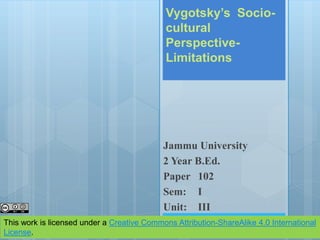
Limitations vygotsky:socio cultural perspective
- 1. Vygotsky’s Socio- cultural Perspective- Limitations Jammu University 2 Year B.Ed. Paper 102 Sem: I Unit: III This work is licensed under a Creative Commons Attribution-ShareAlike 4.0 International License.
- 2. Vagueness of Zone of Proximal Development Zone of Proximal Development (ZPD) is very vague and does not contain an accurate picture of a child’s learning style, current ability level, or motivational factors. It also does not explain the process of development or how exactly development occurs. only knowing the width of chidren's ZPD doesn't provide an accurate picture of their learning ability, style of learning, or current level of development Having a wide or narrow zone can be desirable or undesirable, depending on its causes(provides a very incomplete developmental picture)
- 3. ZPD cannot be measured (No common, metric scale exists to measure an individual child's zone) generality and stability of an individual's zone(one domain equal across all domains, size of a child's zone change over time, guided participation from adults necessary or only helpful for development, Is improvement within the zone long-lasting, or only temporary)
- 4. Insufficient Attention to Developmental Issues developmental account of both contexts and children is needed (little description of contexts of children of various ages or developmental levels, rarely addresses the nature of the cognitive skills that are required for responding to prompts, joint attention, learning from observation, collaborative dialogue, and other such processes) greater attention needs to be paid to a child's cognitive and physical developmental levels themselves. ignores the role of the individual and in contrast emphasizes the social or collective
- 5. mind not seen as independent from the socio-cultural group knowing is relative to the situation in which knower find themselves not acknowledge that there lies a possibility for anyone to rise above social norms based on their ability to generate personal understandings does not acknowledge gifted students or prodigies, who may not experience social interaction with a “more knowledgeable other” but still progress to an expert level) assumed to be applicable to all cultures and abilities
- 6. theory viewed social groups as being a whole and equal, with the probability to take out the same meaning from social interaction. But, collaboration and participation differ for every individual and thus, inequalities exist for each person. Differences in skill-set are always present, offering constraints in learning. A student with autism for example, may not extract the same meaning from group interaction as a student without autism
- 7. Incomplete theory, death at a young age Overtly optimistic No considerations of gender Informal research methods Overemphasis on language and literature Impractical: requires one to one education Underemphasizes individuals
- 8. Ideas of language and thought: language and thought develop on parallel pathways instead of separate tracks For example, a child knows what a ball is before his is able to say the word. A parent may ask the child to find the ball and the child is able to retrieve the correct item before he is able to accurately speak the word "ball.“ This is direct opposition to Vygotsky's idea that the spoken word must be acquired before the thought or concept of ball can develop.
- 9. language theories have a broad outline and are not well drawn out. (rely more on the ideas of cultural influence, cultural helps develop the individual in language and cognitive development According to Vygotsky very little language and development come from biological factors. Modern psychologists dismiss this idea that cultural influences play a dominant role in development of language.
- 10. Cultural tools and cognitive development Cultural Tools A technological tool that can guide a child in communication. Following the use of co-constructed help, children can gain the use of cultural tools which can help them in their independent future. Examples of a cultural tool are televisions, computers, books, etc.
- 11. Culture- material and symbolic tools that accumulate through time and are passed on through social processes and provide resources for the developing child material tools - cultural tools including physical objects and observable patterns of behavior such as family routines and social practices
- 12. symbolic tools - cultural tools such as abstract knowledge, beliefs, and values mediation - the process through which tools organize people's activities and ways of relating to their environments
- 13. explicit instruction - the social process in which children are purposefully taught to use the resources of their culture; uses symbolic communication; animals cannot do this social enhancement - the most basic social process of learning to use cultural resources, in which resources are used simply because others' activities have made them available in the immediate environment
- 14. cumulative cultural evolution - the dynamic ongoing process of cultural change that is a consequence of variation that individuals have produced in the cultural tools they use niche construction - the active shaping and modification of individuals' environments by the individuals own behaviors, activities, and choices co-construction - the shaping of environments through interactions between children and their caregivers, siblings, neighbors, and friends
